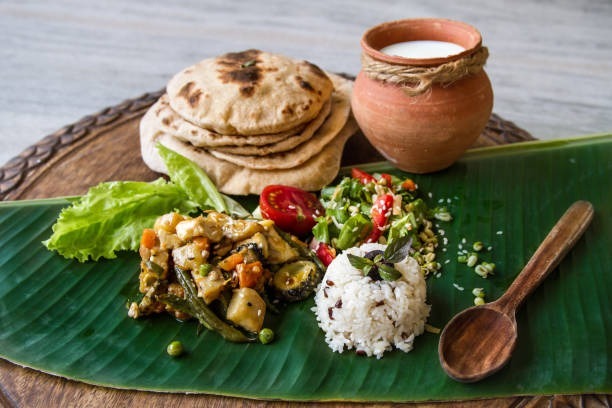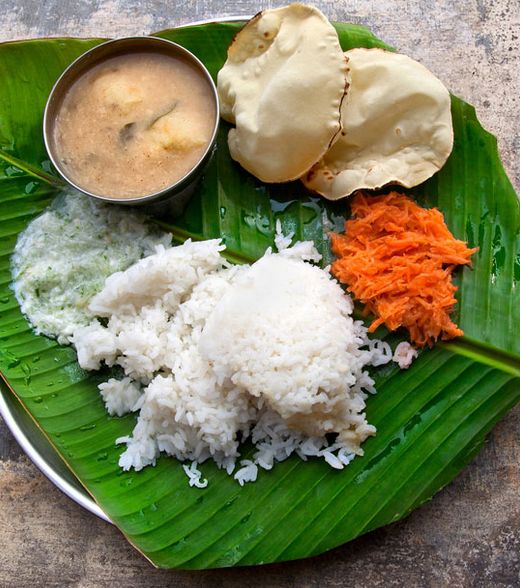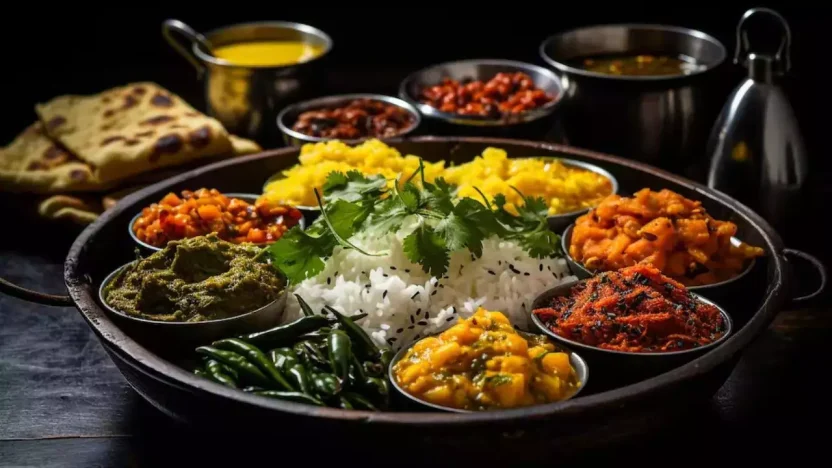Table of Contents

Understanding the Sattvic Diet: A Path to Holistic Wellness
In the diverse landscape of dietary philosophies, the Sattvic diet emerges as a deeply rooted concept from the ancient Indian system of Ayurveda. It emphasizes balance, moderation, and the energetic quality of foods, aligning not only with physical health but also mental and spiritual well-being. This diet is not merely about choosing certain types of foods over others; it’s a holistic approach to living that encourages a harmonious lifestyle in accordance with nature and its rhythms.
The Ayurvedic Concept of Gunas
Ayurveda classifies everything in the universe, including food, into three qualities or “gunas”: sattva, rajas, and tamas. These qualities affect our mind and body in distinct ways:
- Sattva (Purity): Sattvic foods are thought to promote clarity, happiness, and a calm mind, making them ideal for maintaining physical and psychological balance.
- Rajas (Activity): Rajasic foods are associated with motion and stimulation. Often spicy, bitter, or dry, they can provoke mental restlessness and physical discomfort if consumed excessively.
- Tamas (Inertia): Tamasic foods, such as overly processed or stale foods, are believed to cause lethargy, negativity, and confusion.
The Sattvic diet prioritizes foods that are pure, fresh, and naturally nourishing, believed to be imbued with life energy that enhances vital force.
Principles of the Sattvic Diet
The Sattvic diet is finely attuned to the nuances of body and environmental harmony, advocating for:
- Seasonal Eating: Consuming fruits and vegetables that are in season supports the body’s natural nutritional needs throughout the year.
- Freshness: Food should be freshly prepared and consumed soon after cooking to preserve its life energy and nutritional value.
- Moderation (Mitahara): This ancient concept encourages moderate consumption, which is key to maintaining health and longevity.
- Ahimsa (Non-violence): Non-violence is a cornerstone, promoting vegetarianism to avoid harm to other living beings.
- Whole Foods: Emphasizes whole grains, fresh fruits, vegetables, nuts, seeds, and legumes.
- Dairy Ethics: Dairy is acceptable if animals are treated with care and respect, reflecting ethical concerns over animal welfare.
Benefits of a Sattvic Diet
Adopting a Sattvic diet can offer numerous health benefits:
- Improved Digestion: Light and easy to digest, these foods help maintain a balanced digestive system.
- Enhanced Mental Clarity: Foods rich in sattva enhance mental clarity, concentration, and calmness, aiding spiritual practice and meditation.
- Physical Health: Rich in nutrients and naturally detoxifying, these foods support immune health and physical vitality.
- Emotional Balance: The calming effects of a Sattvic diet help regulate emotions, reducing tendencies towards anger, anxiety, and depression.
Implementing the Sattvic Diet
Transitioning to a Sattvic diet involves more than just food choices—it’s about adopting a lifestyle that supports harmony and balance. Here are practical steps for implementation:
- Understand Seasonal Foods: Learn which foods are in season and integrate them into your diet to maximize their health benefits.
- Incorporate Variety: Ensure a balanced intake of fruits, vegetables, nuts, seeds, and whole grains to keep meals interesting and nutritionally complete.
- Cook Fresh Meals: Prepare meals daily using fresh ingredients to harness the maximum energy and nutrients from food.
- Practice Mindful Eating: Eat in a calm environment, focusing on the taste and texture of food, and be mindful of your body’s satiety cues.
- Ethical Dairy Choices: If consuming dairy, choose products from sources that uphold high standards of animal welfare.
Challenges and Considerations
While the Sattvic diet is beneficial, it may not be suitable for everyone’s nutritional needs or lifestyle. Those with specific dietary requirements or chronic health conditions should consult healthcare providers. Additionally, accessing fresh, high-quality ingredients regularly can be a challenge in urban environments.
The Sattvic diet is more than a nutritional guideline; it is a philosophy that fosters a symbiotic relationship between body, mind, and spirit. By nurturing this connection through mindful eating and ethical living, individuals can achieve a state of balance and health that transcends mere physical well-being. This holistic approach, deeply ingrained in Ayurvedic tradition, offers a path to a more mindful, ethical, and healthy way of living in the modern world.
The Essence of Sattva: Unraveling the Depth of Indian Philosophy
Introduction
At the heart of Indian philosophy lies the profound concept of Sattva, a Sanskrit term encapsulating a rich tapestry of meanings and implications. Rooted in ancient wisdom and embedded in the fabric of Indian thought, Sattva transcends mere definitions, embodying purity, vitality, and wisdom. This essay delves into the multifaceted nature of Sattva, exploring its significance within the framework of the three gunas and its manifestation in the Sattvic diet.
also visit : https://www.instagram.com/p/C52V49HSpwZ/?img_index=1
Understanding Sattva: Beyond Words
Sattva, derived from the Sanskrit word सत्त्व (sattva), defies simplistic explanation, encompassing a spectrum of meanings. At its core, Sattva represents purity, essence, and vitality—a state of being imbued with consciousness and truth. It embodies qualities of clarity, strength, and wisdom, serving as the foundation for virtuous living and spiritual growth.
also visit : https://telecastindia.in/?p=1356/?p=1356
The Three Gunas: A Triad of Qualities
In Indian philosophy, reality is classified into three fundamental qualities or gunas: Sattva, Rajas, and Tamas. These gunas pervade all aspects of existence, shaping the nature of beings and phenomena:
- Sattva: The quality of purity, harmony, and equilibrium. It represents luminosity, intelligence, and serenity.
- Rajas: Characterized by activity, passion, and restlessness. Rajasic tendencies manifest as desire, ambition, and attachment.
- Tamas: The quality of darkness, inertia, and ignorance. Tamasic influences lead to dullness, lethargy, and delusion.
Sattva stands as the pinnacle of this triad, representing the highest state of consciousness and evolution.
Contrasting Sattva and Tamas: The Dance of Light and Darkness
Sattva and Tamas exist as polar opposites, embodying diametrically opposed qualities and tendencies:
- Sattva: Radiant and pure, Sattva illuminates the path to enlightenment. It fosters clarity, compassion, and transcendence, leading to spiritual liberation.
- Tamas: Shrouded in darkness, Tamas represents ignorance and inertia. It obscures truth, stifles growth, and binds individuals to worldly delusions.
The journey towards Sattva involves transcending the limitations of Tamas, embracing light over darkness, and cultivating virtues that elevate consciousness.
The Sattvic Diet: Nourishment for Body and Soul
The Sattvic diet emerges as a tangible expression of Sattva in daily life, guiding individuals towards holistic well-being through conscious food choices and eating habits. Rooted in the principles of purity and vitality, the Sattvic diet encompasses:
- Pure and Natural Foods: Sattvic foods are minimally processed, free from artificial additives, and sourced from nature’s bounty. They include fresh fruits, vegetables, whole grains, nuts, seeds, and dairy products obtained ethically.
- Energetically Balanced Meals: Sattvic meals are thoughtfully prepared to maintain energetic equilibrium, combining various tastes, textures, and nutrients to nourish body and soul.
- Mindful Eating: Practitioners of the Sattvic diet approach eating with mindfulness and gratitude, savoring each morsel and acknowledging the life-sustaining energy within.
Embodying Sattva: Cultivating Virtue and Wisdom
Beyond dietary preferences, embodying Sattva entails cultivating virtues and qualities that align with its essence. It involves:
- Purity of Intent: Acting with integrity, honesty, and compassion in all endeavors.
- Clarity of Mind: Cultivating inner peace, discernment, and wisdom through practices such as meditation and self-reflection.
- Harmonious Living: Nurturing relationships, environments, and lifestyles that promote balance, harmony, and well-being.

Challenges and Reflections
While the ideals of Sattva inspire noble aspirations, embodying them in daily life poses challenges:
- Inner Struggles: Overcoming egoic tendencies, emotional fluctuations, and societal conditioning requires sustained effort and self-awareness.
- External Influences: Navigating a world dominated by Rajasic and Tamasic influences presents obstacles to maintaining Sattvic purity and clarity.
In the intricate tapestry of Indian philosophy, Sattva shines as a beacon of light and wisdom, guiding seekers on the path to transcendence and self-realization. Rooted in the timeless wisdom of the ancients, Sattva beckons humanity towards a higher consciousness—a state of being characterized by purity, vitality, and truth. Through the practice of a Sattvic diet and the cultivation of virtuous qualities, individuals can embody the essence of Sattva, transforming their lives and contributing to the collective evolution of humanity.
Exploring the Ayurvedic Principles of Sattvic, Rajasic, and Tamasic Foods
Introduction
Ayurveda, the ancient Indian system of medicine, offers profound insights into the relationship between sattvic food and well-being. Central to Ayurvedic philosophy are the concepts of Sattva, Rajas, and Tamas—three fundamental qualities that characterize all aspects of existence, including food. This essay delves into the Ayurvedic principles underlying Sattvic, Rajasic, and Tamasic foods, exploring their composition, effects on body and mind, and implications for overall health and vitality.
The Elemental Basis of Food: Prithvi, Jala, Teja, Vayu, and Akash
According to Ayurveda, all substances, including food, are composed of varying combinations of the five basic elements: Prithvi (earth), Jala (water), Teja (fire), Vayu (air), and Akash (ether). Each element carries specific qualities and attributes, influencing the nature and effects of the substances they comprise. Understanding the elemental composition of food is essential for discerning its impact on the body and mind.
Sattvic Foods: Nourishing Body and Spirit
Sattvic foods embody qualities of purity, vitality, and harmony, aligning with the principle of Sattva—a state of balanced consciousness and spiritual clarity. These foods are fresh, wholesome, and nourishing, derived from natural sources and prepared with care. Examples of Sattvic foods include fresh fruits, vegetables, whole grains, nuts, seeds, dairy products, and herbs. Sattvic foods promote physical health, mental clarity, and spiritual well-being, fostering a sense of lightness, vitality, and inner peace.
Rajasic Foods: Stimulating and Agitating
Rajasic foods are characterized by qualities of stimulation, intensity, and agitation, reflecting the principle of Rajas—the quality of activity and passion. These foods are typically spicy, hot, fried, or acidic, and they stimulate the senses and the mind. Examples of Rajasic foods include spicy dishes, caffeinated beverages, fried foods, and overly processed or refined products. While Rajasic foods may provide temporary energy and stimulation, excessive consumption can lead to restlessness, irritability, and imbalance in the body and mind.
Tamasic Foods: Heavy and Dulling
Tamasic foods embody qualities of inertia, heaviness, and dullness, aligning with the principle of Tamas—the quality of darkness and stagnation. These foods are often heavy, processed, and difficult to digest, leading to lethargy, dullness, and a sense of heaviness in the body and mind. Examples of Tamasic foods include meat, fish, eggs, onions, garlic, mushrooms, alcohol, and stale or preserved foods. Consuming Tamasic foods can dull the senses, cloud the mind, and disrupt the body’s natural equilibrium, leading to physical and mental imbalances.
Principles of Ayurvedic Nutrition: Harmony and Balance
Ayurvedic nutrition emphasizes the importance of consuming foods that promote harmony and balance in the body and mind. This involves choosing Sattvic foods that nourish and uplift the spirit, while minimizing the intake of Rajasic and Tamasic foods that disturb the natural balance. Ayurveda also recognizes the concept of incompatible food combinations (viruddha), which can disrupt digestion and lead to imbalances in the body. Examples of incompatible food combinations include mixing fruits with dairy products, consuming fish with milk, or combining sour foods with milk products.
The Role of Digestion: Agni and Ama
Central to Ayurvedic nutrition is the concept of Agni—the digestive fire—which governs the process of digestion and assimilation of nutrients. A strong and balanced Agni is essential for optimal health and vitality, allowing the body to extract nourishment from food and eliminate waste efficiently. Consuming foods that support Agni, such as fresh, light, and easily digestible Sattvic foods, promotes robust digestion and metabolism. Conversely, consuming heavy, processed, or incompatible foods can weaken Agni and lead to the accumulation of Ama—undigested toxins and waste products—in the body, contributing to disease and imbalance.
Practical Tips for Ayurvedic Eating
Incorporating Ayurvedic principles into daily eating habits can promote health, vitality, and well-being. Some practical tips for Ayurvedic eating include:
- Choose Sattvic Foods: Prioritize fresh, organic, and whole foods that nourish and uplift the body and spirit.
- Eat Mindfully: Practice mindful eating by savoring each bite, chewing food thoroughly, and paying attention to hunger and satiety cues.
- Balance Your Plate: Aim for a balanced combination of carbohydrates, proteins, and healthy fats in each meal, tailored to your individual constitution and needs.
- Favor Seasonal Foods: Eat seasonally and locally to align with the natural rhythms of the environment and support optimal health.
- Avoid Incompatible Combinations: Be mindful of food combinations that may disrupt digestion and lead to imbalances in the body.
- Cultivate Awareness: Develop a deeper understanding of your body’s needs and responses to different foods, and adjust your diet accordingly to promote balance and vitality.
- also read : https://telecastindia.in/unlock-creativity-5-stunning-ways-meta-ai-transfo/
In conclusion, Ayurvedic principles of nutrition offer valuable insights into the relationship between food, health, and well-being. By understanding the qualities of Sattvic, Rajasic, and Tamasic foods, as well as the elemental basis of food composition, individuals can make informed choices that support optimal health and vitality. Embracing a diet rich in Sattvic foods while minimizing the intake of Rajasic and Tamasic foods can promote physical, mental, and spiritual balance, fostering a sense of harmony and well-being in body and mind. Through mindful eating, conscious food choices, and a reverence for the natural world, we can cultivate health, vitality, and longevity in alignment with the wisdom of Ayurveda.
Discover more from Telecast India
Subscribe to get the latest posts sent to your email.

